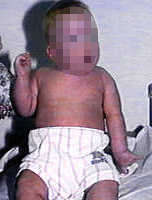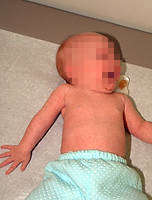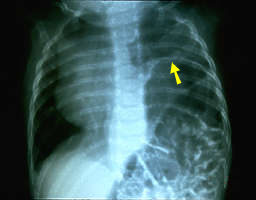Identification
Infants with brachial plexus injury are usually identified in the newborn nursery during the first week of life. The most obvious feature of the disorder is lack of mobility in the arm.

|
This infant had injuries to the upper brachial plexus (nerves C5 and C6) of the left arm. The arm is in the typical "waiter's tip hand" position. The infant cannot elevate the shoulder, flex the elbow, or turn the arm out. |

|
This infant has total brachial plexus palsy of the right arm. The shoulder, arm, wrist, and fingers have no movement. The arm is limp and will stay in whatever position it is placed. |
Associated Symptoms
The following symptoms are commonly associated with brachial plexus injury:
Horner's Syndrome
Horner's syndrome consists of a droopy eyelid and constricted pupil on the side of the brachial plexus injury. It reflects injury to the sympathetic nerve at the C8-T1 level (see Anatomy section). There is little chance for spontaneous recovery.
Phrenic Nerve Injury
The phrenic nerve controls the diaphragm, which moves with respiration. A paralyzed diaphragm causes breathing difficulty, asymmetric chest movement during respiration, and frequent lung infections.
This chest x-ray shows marked upward displacement of the diaphragm away from the normal level; bowels are seen in the chest cavity. Diaphragm paralysis can resolve spontaneously but requires particular attention because it can cause death. Plication of the diaphragm by a thoracic surgeon and nerve grafting to the phrenic nerve are alternative treatments for phrenic nerve injury.

Facial Palsy and Spinal Cord Injury
Facial palsy and spinal cord injury are rare. When spinal cord injury occurs with brachial plexus injury, the phrenic nerve can also be damaged, causing paralysis of the diaphragm, which compounds respiratory difficulties.
Clavicle Fracture and Shoulder Dislocation
Clavicle (collarbone) fracture is relatively common in association with brachial plexus injury. It is important to document that there are no injuries to the clavicle, shoulder, or upper arm. This is commonly done with plain x-rays. Shoulder dislocation can occur any time, even after birth, due to the lack of muscular protection of the shoulder.










